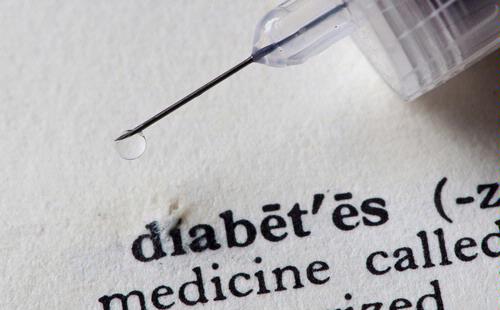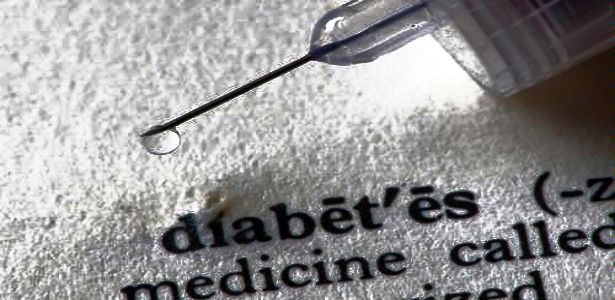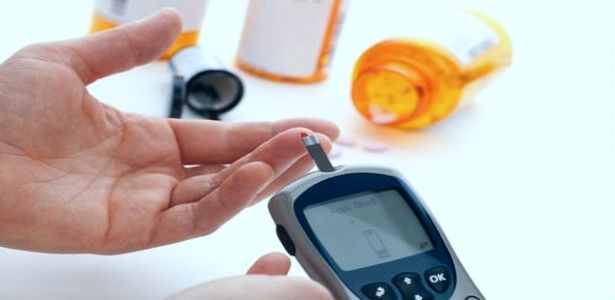 KOMPAS.com — Ini adalah peringatan betapa diabetes akan menjadi ancaman dan beban serius pada masa mendatang. Studi terbaru menunjukkan, diabetes
tidak hanya akan memicu risiko mengidap penyakit-penyakit berat, tetapi
juga dapat memangkas harapan hidup seseorang selama beberapa tahun.
KOMPAS.com — Ini adalah peringatan betapa diabetes akan menjadi ancaman dan beban serius pada masa mendatang. Studi terbaru menunjukkan, diabetes
tidak hanya akan memicu risiko mengidap penyakit-penyakit berat, tetapi
juga dapat memangkas harapan hidup seseorang selama beberapa tahun.Awas....! Diabetes Bikin Umur Pendek
Ini adalah peringatan betapa diabetes akan menjadi ancaman dan beban serius pada masa mendatang. Diabetes selama ini dikenal sebagai penyakit yang dapat melipatgandakan risiko terserang penyakit pembuluh darah, jantung, dan stroke. Namun . . .
Hati-hati Diabetes Pada Anak
Bagaimana cara mengatasi gejala diabetes pada anak – anak sebelum terlambat dan menjadi semakin parah? Yang mereka rasakan hanyalah terganggu karena ada gejala yang tidak biasa dan mereka menunjukkan gangguan itu dengan cara menangis atau mungkin jadi tampak lemas, tidak bergairah dan mudah rewel. Karena memang seperti itulah bahasa anak – anak.
14 Jenis Imunisasi Wajib untuk Anak
Selain memperhatikan gizi dan menjaga kesehatan, imunisasi adalah salah satu cara pencegahan utama terhadap suatu penyakit. Imunisasi merupakan program untuk memenuhi Konvensi Hak Anak PBB, sehingga pemerintah dan orangtua wajib memberikan upaya kesehatan yang terbaik untuk anak, meliputi pemberian imunisasi. Apa saja jenis imunisasi tersebut?
Goji Berry 'Buah Panjang Umur'
Goji adalah salah satu buah kesehatan di Cina dan juga yang dikenal sebagai buah panjang umur. Menurut sejarah kuno banyak kaisar Cina mengkonsumsi goji untuk mendapatkan kesehatan dan umur panjang. Kenapa bisa begitu ?
Diabetes Bukan karena Kebanyakan Gula ?
Dunia sedang menghadapi ledakan penderita diabetes. Data paling baru menyebutkan angkanya mencapai 350 juta orang di seluruh dunia, jauh melebihi prediksi Federasi Diabetes International (IDF) yang memproyeksikan tahun 2010 ada 285 juta penduduk dunia yang akan menjadi korban penyakit yang bisa merenggut penglihatan, bahkan kematian ini. "Yang harus dibatasi sebenarnya bukan hanya gula, tetapi .. " papar dokter dari Divisi Endokrinologi dan Metabolisme Departemen Ilmu Penyakit Dalam FKUI/RSCM Jakarta.
Monday, July 16, 2012
Awas....! Diabetes Bikin Umur Pendek
 KOMPAS.com — Ini adalah peringatan betapa diabetes akan menjadi ancaman dan beban serius pada masa mendatang. Studi terbaru menunjukkan, diabetes
tidak hanya akan memicu risiko mengidap penyakit-penyakit berat, tetapi
juga dapat memangkas harapan hidup seseorang selama beberapa tahun.
KOMPAS.com — Ini adalah peringatan betapa diabetes akan menjadi ancaman dan beban serius pada masa mendatang. Studi terbaru menunjukkan, diabetes
tidak hanya akan memicu risiko mengidap penyakit-penyakit berat, tetapi
juga dapat memangkas harapan hidup seseorang selama beberapa tahun.Penderita Diabetes Teledor, 5 Organ Taruhannya
 KOMPAS.com — Sekitar
tahun 2000, International Diabetes Federation (IDF) menyebutkan bahwa
diabetes merupakan penyakit keempat penyebab utama kematian di banyak
negara maju.
KOMPAS.com — Sekitar
tahun 2000, International Diabetes Federation (IDF) menyebutkan bahwa
diabetes merupakan penyakit keempat penyebab utama kematian di banyak
negara maju. Secara umum, sekitar 40 persen pasien diabetesi, entah tipe I (yang dialami sejak masa kanak-kanak atau yang tergantung insulin) dan atau tipe II (yang mulai dialami saat dewasa dan tidak tergantung insulin) akan mengalami komplikasi dalam perjalanan hidupnya.
Bila gula darah tidak terkendali karena pola makan yang tidak tepat, kebiasaan hidup tidak sehat, seperti merokok dan kurang kegiatan fisik, tetap dipertahankan, komplikasi bakal menyerang ke mana dia suka.
Berikut ini adalah organ-organ yang menjadi sasaran komplikasi akibat keteledoran para diabetesi:
1. Jantung - penyakit jantung koroner (PJK)
Keadaan ini muncul akibat glukosa darah yang tinggi dan terus-menerus atau persisten. Akibatnya, terjadinya penebalan dan pengerasan pembuluh darah arteri atau sering disebut aterosklerosis. Diabetesi berisiko dua sampai empat kali lebih tinggi terkena penyakit kardiovaskular dibandingkan yang tidak mengalami DM.
2. Otak - stroke
Aterosklerosis dapat terjadi di pembuluh darah otak. Akibatnya bisa ditebak, terjadi stroke. Risiko terserang stroke pada diabetesi yang juga mengalami hipertensi adalah dua kali lebih tinggi dibanding orang yang hanya menderita hipertensi saja.
3. Kaki - luka
Ulser atau luka pada kaki merupakan penyebab paling umum yang mengantar diabetesi masuk rumah sakit. Komplikasi ini terjadi akibat kerusakan saraf (neuropati) dan kurangnya aliran darah ke kaki.
Jika luka terinfeksi dan berkembang menjadi gangren, biasanya amputasi dilakukan. Diabetes merupakan penyebab amputasi yang paling sering di luar kecelakaan. Setidaknya 15-40 persen diabetesi lebih berisiko mengalami hal ini dibanding yang tidak.
4. Mata - retinopati
Retinopati diabetik merupakan komplikasi DM pada mata. Penglihatan mendadak akan buram atau berkabut. Ini terjadi akibat kadar gula darah yang tinggi sehingga terjadi sembab pada lensa mata. Bila pengobatan cukup dan kadar gula terkontrol, penglihatan pun akan normal lagi.
5. Ginjal - nefropati
Nefropati diabetes adalah komplikasi yang terjadi pada ginjal. Ini komplikasi yang menyebabkan terjadinya gagal ginjal dan kematian. Penyebabnya, kadar glukosa darah yang tinggi sehingga merusak pembuluh darah kapiler ginjal dan menyebabkan terjadinya tekanan darah tinggi.
Risiko terjadi serta berat atau ringannya komplikasi ginjal ini sejalan dengan lamanya DM diidap. Kebanyakan komplikasi muncul setelah 10-15 tahun penderita mengidap DM. @abd
Friday, July 13, 2012
Benarkah Diabetes Sebabkan Disfungsi Ereksi?
Berdasarkan hasil pemeriksaan dokter, kadar gula darah KHH mencapai 621. "Mana mungkin penderita diabetes yang kadarnya sangat tinggi bisa ereksi. Kalau enggak percaya, silakan tanya dokter," tegasnya, Kamis (14/1/2010).
Lantas, benarkah diabetes menyebabkan seorang lelaki kehilangan vitalitasnya sehingga tak bisa menghamili wanita? Tentu pertanyaan ini membutuhkan telaah medis yang lebih dalam. Berdasarkan penjelasan dr Sandra Utami Widiastuti, SpPD dari Diabetic & Wound Care Clinic RS Siloam Kebon Jeruk, Jakarta, yang dihubungi Kompas.com, impotensi atau disfungsi ereksi (DE) merupakan salah satu komplikasi penyakit diabetes melitus.
 Menurut
dia, hampir 50 persen penderita diabetes (diabetesi) menderita
disfungsi ereksi dalam skala berat dan ringan. Meski begitu, gangguan
ereksi ini umumnya terjadi pada pria yang diabetesnya menahun. "Diabetes
yang sudah cukup lama bisa mengganggu sel-sel saraf dan pembuluh darah,
padahal ereksi yang baik membutuhkan rangsangan saraf dan pembuluh
darah yang baik. Karena itu, pasien diabetes bisa menderita impotensi,"
paparnya.
Menurut
dia, hampir 50 persen penderita diabetes (diabetesi) menderita
disfungsi ereksi dalam skala berat dan ringan. Meski begitu, gangguan
ereksi ini umumnya terjadi pada pria yang diabetesnya menahun. "Diabetes
yang sudah cukup lama bisa mengganggu sel-sel saraf dan pembuluh darah,
padahal ereksi yang baik membutuhkan rangsangan saraf dan pembuluh
darah yang baik. Karena itu, pasien diabetes bisa menderita impotensi,"
paparnya.Disfungsi ereksi adalah suatu keadaan di mana terdapat ketidakmampuan untuk mencapai atau mempertahankan ereksi agar bisa berhubungan seksual secara memuaskan. Para ahli pun sepakat bahwa 80 persen kasus disfungsi ereksi disebabkan kondisi fisiologis, termasuk penyakit jantung dan diabetes.
Menurut dr Sandra, umumnya hal ini terjadi akibat tersumbatnya aliran darah ke penis yang salah satunya disebabkan oleh diabetes. Namun, terjadinya komplikasi diabetes berbeda-beda pada tiap individu.
"Proses bagaimana pengaruh diabetes pada fungsi ereksi sebenarnya panjang. Namun, bisa saja seseorang mengalami DE, padahal baru divonis diabetes. Mungkin perjalanan penyakit diabetes orang itu sudah lama, tetapi tidak dirasakan. Ia baru memeriksakan diri setelah muncul keluhan," papar dr Sandra.
Untuk mengatasi gangguan ereksi akibat diabetes, dr Sandra menegaskan pentingnya pengendalian gula darah. Selain itu, biasanya dokter juga akan meresepkan obat-obatan untuk meregenerasi sel saraf dan pembuluh darah.
"Tidak menutup kemungkinan juga untuk berkonsultasi kepada dokter andrologi untuk mengevaluasi adanya sebab lain penyebab impotensi. Namun, yang utama adalah kendalikan dulu gula darah," katanya.
Dengan demikian, jelaslah, meski diabetes membawa risiko pada rusaknya fungsi ereksi, toh hal itu tidak mutlak terjadi....
- Bagaimana menyeimbangkan Kadar Gula Darah Secara Alami..?
- Penyakit Diabetes bisakah disembuhkan...???
Mengapa Pria Rentan Diabetes?
Diabetes tipe 2 terjadi karena terlalu banyak glukosa dalam darah akibat kemampuan tubuh untuk mengatur kadar gula di beberapa organ terganggu. Kondisi ini berkaitan dengan kelebihan lemak di beberapa organ tubuh seperti liver dan otot.
Profesor Naveed Sattar dari Institute of Cardiovaskular & Medicine Sciences mengatakan, beberapa penelitian telah mengindikasikan pria usia pertengahan beresiko tinggi menderita diabetes dibanding wanita.
Salah satu penjelasannya karena untuk menderita penyakit ini pria hanya perlu bertambah berat badan sedikit dibanding wanita. Dengan kata lain, pria bisa menderita diabetes pada indeks massa tubuh yang lebih rendah daripada wanita.
Sattar dan timnya percaya, distribusi lemak berperan penting dalam terjadinya diabetes. Pada pria, lemak lebih banyak berkumpul di sekitar pinggang dan liver. Sementara wanita memiliki lebih banyak lemak subkutan yang aman yang disimpan di paha dan pinggul.
Dalam penelitian ini, para ahli menganalisa data 51.920 pria dan 43.137 wanita di Skotlandia yang menderita diabetes. Mereka diukur berat badannya menggunakan pengukuran indeks massa tubuh (IMT).
Hasilnya wanita yang menderita diabetes memiliki nilai IMT yang lebih tinggi dibanding pria yang juga penderita diabetes. Hal ini juga menjelaskan mengapa di banyak negara lebih banyak pria yang menderita diabetes tipe 2.
Saturday, June 30, 2012
Kelamaan Nonton TV Bisa Sakit Diabetes
 KOMPAS.com — Penelitian
menunjukkan, mereka yang menghabiskan waktu berjam-jam di depan
televisi berisiko lebih besar mengalami kematian, mengidap diabetes dan
penyakit jantung. Bahkan, dengan rutin menonton televisi selama dua jam
sehari pun bisa berdampak signifikan bagi kesehatan.
KOMPAS.com — Penelitian
menunjukkan, mereka yang menghabiskan waktu berjam-jam di depan
televisi berisiko lebih besar mengalami kematian, mengidap diabetes dan
penyakit jantung. Bahkan, dengan rutin menonton televisi selama dua jam
sehari pun bisa berdampak signifikan bagi kesehatan.Setiap hari, penduduk di Amerika Serikat menghabiskan waktu rata-rata 5 jam untuk duduk di depan layar kaca, sementara orang Australia dan beberapa orang Eropa menghabiskan antara 3,5 jam dan 4 jam sehari. Data ini disampaikan para ahli dari Harvard School of Public Health.
"Pesan ini sederhana. Mengurangi waktu menonton TV adalah cara penting untuk mengurangi kebiasaan duduk secara terus-menerus dan mengurangi risiko diabetes dan penyakit jantung," kata Frank Hu, salah seorang peneliti.
Dia menambahkan, orang yang duduk di depan televisi tidak hanya menjadi kurang berolahraga, tetapi juga cenderung menyantap makanan tidak sehat. "Kombinasi gaya hidup banyak duduk, pola makan tidak sehat, dan obesitas menciptakan 'daerah pembiakan sempurna' untuk diabetes tipe 2 dan penyakit jantung," tuturya.
Ini bukan penelitian pertama yang menghubungkan durasi menonton TV dengan penyakit. Banyak penelitian menemukan hubungan yang kuat antara menonton televisi dan obesitas, dan sebuah laporan pada 2007 menemukan bahwa waktu menonton TV berhubungan dengan tekanan darah tinggi dan obesitas anak-anak.
Penelitian lain pada tahun sama menemukan, anak-anak dengan kategori overweight yang menonton iklan makanan cenderung menggandakan asupan makanan mereka.
Untuk keperluan penelitian terbaru ini, Hu dan timnya mengkaji 8 penelitian yang menguji hubungan antara durasi menonton televisi dan penyakit. Penelitian yang dipublikasikan Journal of the American Medical Association itu melibatkan lebih dari 200.000 orang dalam jangka waktu 7 hingga 10 tahun.
Hu dan para koleganya menemukan, untuk setiap dua jam sehari menonton televisi, risiko mengidap diabetes meningkat 20 persen, sedangkan risiko penyakit jantung naik 15 persen. Menonton televisi dua jam setiap hari juga dapat meningkatkan risiko kematian sebanyak 13 persen.
Berdasarkan temuan itu, Hu dan timnya memperkirakan, di antara 100.000 orang, membatasi waktu menonton televisi hingga 2 jam dapat mencegah 176 kasus baru diabetes, 38 kasus penyakit kardiovaskuler fatal, dan 104 kematian dini setiap tahun.
Peneliti mengingatkan, hasil riset ini tidak serta merta membuktikan bahwa menonton TV adalah satu-satunya faktor yang meningkatkan risiko penyakit. "Benar bahwa antara mereka yang banyak menonton TV dan mereka yang menonton dalam waktu lebih sedikit memiliki perbedaan terutama dalam hal pola makan dan tingkat aktivitas fisik," kata Hu.
Ia menambahkan, mereka yang keranjingan menonton TV cenderung menyantap makanan tidak higienis. Pola makan tidak sehat dan kemalasan juga akibat dari menonton televisi berkepanjangan. Jadi, penelitian itu menjelaskan betapa besar dampak merugikan dari kebiasaan duduk selama berjam-jam.
Penyakit Diabetes bisakah disembuhkan....???
Sunday, June 17, 2012
Risiko Amputasi Ancam Pasien Diabetes
Diabetic Complications
Authors: Janet Worsley Norwood and Charles B. Inlander
Excerpt from: Understanding Diabetes
Generally, you can't tell diabetic complications are developing, at least not without undergoing tests or medical procedures in a doctor's office. Diabetes proceeds unnoticed, silently ravaging the body. You might be without symptoms until some damage is already done.
There is, however, one surefire indication that problems are developing: persistently high blood-sugar levels. Diabetes experts believe that over the long haul levels above 240 mg/dl are unacceptable and dangerous. However, the ideal level for you is the target set by you and your physician. It will probably be in the 80 to 120 mg/dl range.
The length of time a person has diabetes also comes into play when looking at complications. Because people with type 1 diabetes usually get the disease earlier in life than those with type 2, they have the dubious distinction of running a greater risk of developing complications than those with type 2. For the most part, complications appear in people who have had diabetes for fifteen years or more, although certain short-term complications can appear (and disappear) at any time. Evidence of diabetes-related eye problems, for example, is present after five years in 1 percent of type 1 cases; by fourteen years, the percentage is close to 100.
The type of complications that develop also depends on diabetes type. Individuals with type 1 tend to develop different problems than those with type 2. For instance, type 1 diabetes tends to produce vision problems sooner than does type 2 diabetes, while type 2 diabetes appears to be linked to more heart attacks and strokes. The rates at which complications proceed also vary wildly.
Scientists don't really know why these differences exist. Nor do they know why complications sometimes develop in people who have blood-sugar levels firmly in hand while other people never develop complications, regardless of how well or how poorly they control their blood sugar. It may boil down to genetic differences or even to factors yet unknown.
The thing to remember is that everyone has different responses to high and low blood sugar, so you may want to know what their symptoms tend to be. Self-monitoring of blood glucose can track sugar patterns and guard against these short-term, but potentially deadly, complications.
Long-Term ComplicationsLong-term, chronic complications differ from short-term complications in that they take more time in developing, and once they arrive are less likely to disappear. Many long-term complications are tied to those structures that distribute blood throughout the body; the small and large blood vessels. Although scientists are not certain how it happens, they think that years of carrying blood with high sugar levels eventually damages or impairs blood vessels. The faulty metabolism of someone with diabetes may also create some chemical change that makes blood vessels more vulnerable to damage. Either way, many diabetic complications are vascular complications--complications pertaining to blood vessels, in other words.
Let's look now at some of the major long-term complications faced by people with diabetes.
EYE PROBLEMS
Eye problems that diabetes might cause include minor problems in focusing, premature development of cataracts, and various degrees of retinal damage (otherwise known as diabetic retinopathy).
If you have diabetes, it's very likely that you will experience at least one of these problems in the course of your lifetime. Most people who have had diabetes for five to ten years show some signs of eye damage, although it may be slight.
Cataracts
A cataract, a clouding of the lens in the eye, is a very common problem in older people, including folks who don't have diabetes. However, the evidence suggests that diabetes accelerates cataract development. The hastened development is thought to be a result of the intricate and still incompletely understood relationship between high blood-sugar levels and aging. One popular theory posits that when people have diabetes for an extended period of time, sugar by-products begin to build up in the lens of the eye, eventually leading to cataracts.
Mild cataracts are often left as they are--but an individual with diabetes is encouraged to work at keeping blood-sugar levels within the normal range, which seems to slow the accumulation of sugar by-products and, thus, slow the progression of complications. Once severe cataracts develop, however, many ophthalmologists believe that the best course of action is to remove the cataract and replace it with an artificial lens, also known as an intraocular lens. This surgical procedure can be done right in a doctor's office. Although cataracts certainly impede good vision, they are less troublesome than another long-term complication, diabetic retinopathy.
Diabetic Retinopathy
Diabetic retinopathy means damage to or disease of the retina, the delicate membrane that lines the inside wall of the eye. The retina responds to light and receives the image formed by the lens. When it becomes seriously damaged, blindness may result. In fact, retinopathy is the most frequent cause of vision loss in Americans 20 to 74 years old.
Diabetic retinopathy is caused by changes or abnormalities in the small blood vessels of the retina--changes that take years to occur. Experts estimate that 6,000 people a year develop retinopathy. Fortunately, early diagnosis and prompt treatment often can prevent blindness.
Almost everyone with diabetes develops this complication, but the first to feel its impact are people with type I diabetes, who frequently develop a mild form of this condition within five years of diagnosis of diabetes. In fact, there's a strong correlation between the amount of time someone has diabetes and the development of retinopathy. Quite simply, the longer you have diabetes, the greater your chance of developing retinopathy. Within ten years of diabetes diagnosis, half of all people with type 1 diabetes and a quarter with type 2 have some damage to their retinas. By twenty years after diagnosis of diabetes, nearly everyone with type 1 diabetes and over 60 percent with type 2 have some degree of retinopathy.
Retinopathy is not something to ignore. Among those with type 1 diabetes, retinopathy is responsible for four-fifths of all cases of blindness: among those with type 2, the number is one-third. Of course, not all cases of retinopathy result in blindness. The condition ranges in severity from mild to advanced.
The medical profession describes two forms of diabetic retinopathy: background retinopathy and proliferative retinopathy. Background retinopathy is a mild, early form of retinopathy that is characterized by gradual narrowing or weakening of the small blood vessels in the eye. Small bulges (called microaneurysms) develop on the vessels. Eventually a vessel may tear or break and then bleed (known in medical parlance as a hemorrhage).
Most folks with diabetes develop background retinopathy, but in the lion's share of the cases, the condition remains at a mild level. Vision is not affected unless blood vessels break and leak fluid into the macula, an area of the retina responsible for sharp, fine vision---the kind of vision needed to read this book. When fluid leaks into the macula, it swells and puts pressure on other areas of the eye. This situation is called a macular edema and it leads to blurred vision. The swelling is sometimes treated in people who appear to be at high risk for blindness with a high-tech procedure known as photocoagulation. In this, a precise laser beam is used to sear shut the leaking blood vessels. Photocoagulation doesn't cure retinopathy, but it can delay the loss of vision by a number of years or, in some cases, stop progression.
For the most part, however, because background retinopathy is mild, surgical treatment isn't necessary.
Proliferative retinopathy, as its name suggests, is a severe form of retinopathy that develops when a network of new, fragile blood vessels proliferates in the retina at the site of previous breakages or hemorrhages. The new vessels are an attempt by the eye to repair the damaged, worn-out vessels caused by diabetes. Over time the new, fragile vessels may tear and leak blood into the vitreous humor, the clear, gelatinous material that fills the center of the eye. A small amount of blood won't dim vision, but the major hemorrhages associated with proliferative retinopathy may be large enough to affect sight, in which case they are known as vitreous hemorrhages.
As the eye tries to repair the damage caused by hemorrhages, scar tissue forms. The buildup of scar tissue may eventually damage the retina, resulting in partial loss of sight, or it may displace or cause the retina to become detached, resulting in total loss of vision.
It may be difficult to tell if either form of retinopathy is developing. For the most part, people can have severe eye damage without knowing it, because the damage may not affect vision and may cause no pain. Of course, there are some obvious indications to the person with diabetes that something has happened to the eye. Partial loss of vision--even if very small--is an indication of a problem. "Floaters," "cobwebs," and "cotton wool balls" are terms that people have used to describe vision problems caused by tiny hemorrhages in the eye. A sudden, painful loss of vision may indicate a major hemorrhage.
Naturally, it's best to detect retinopathy before it reaches this stage. Eye examinations with a tool called a monocular direct ophthalmoscope are used to detect damage to the retina. A family physician can perform this test, although several studies indicate that physicians who are not ophthalmologists detect proliferative retinopathy in only 50 percent of the people who have the condition. That's not a particularly encouraging track record--"No better than random chance," in the words of one eye expert.
There are some treatment options for those people with advanced stages of either form of retinopathy: Photocoagulation--the use of laser beams---can seal leaking retinal blood vessels or reattach a detached retina. In some people, this is enough to stop the progression of diabetic retinopathy.
Vitrectomy is another, more intricate surgical procedure used in people with proliferative retinopathy. In this procedure, a physician removes the vitreous to clear out the light-blocking hemorrhage, uses microsurgery to repair the retina, if necessary, and then replaces the vitreous with a saline solution.
An article in the journal Annals of International Medicine explains that photocoagulation and vitrectomy prevent deterioration of vision in around 60 percent of patients. Laser therapy reportedly reduces the rate of vision loss by 50 percent in people with proliferative retinopathy and macular edema, conditions that often exhibit no symptoms. Vicrectomy reportedly improves visual acuity to 10/20 or better in 36 percent of treated eyes. That's the good news.
However, no surgery is free of potential complications. With vitrectomy, for example, the overall complication rate is about 25 percent, according to the Annals of International Medicine article. Potential complications include infection, cataract development, bleeding, elevated pressure in the eye (which can lead to a condition called glaucoma), loss of vision, and retinal detachment or scarring.
Medical research is also looking at ways of slowing or even preventing the progression of retinopathy. One small Norwegian study found that people with type 1 diabetes who maintained near-normal levels of blood sugar over a long period of time--at least seven years--were significantly less likely to develop severe retinopathy. The patients in this study followed a tight-control regimen, using either continuous subcutaneous infusion pumps or multiple insulin injections.
The results of the Diabetes Control and Complications Trial show that tight blood-sugar control can prevent new cases of retinopathy. Tight control also helps retinopathy from growing worse, According to the study, the earlier tight control is instituted, the more beneficial it is at fending off complications.
Scientists are also hoping to discover why high levels of blood glucose damage the body's blood vessels. One theory is that an enzyme called aldose reductase, which converts glucose into a sugar alcohol called sorbitol, may play a role in triggering diabetic complications. For that reason researchers are looking into a class of drugs called aldose reductase inhibitors that block the actions of the enzyme. They hope these drugs can reduce the chance of developing retinopathy and other long-term complications. Studies are underway.
In November 1997, the Journal of the American Medical Association reported on a number of other agents that may potentially prevent retinopathy. These include aminoguanidine, a drug that inhibits the formation of certain proteins and lipids that are thought to contribute to blood vessel damage. Other possibilities include drugs that interfere with the growth of blood vessels in the retina; antioxidants such as vitamin E, thought to prevent damage to the endothelium (the innermost layer of the cornea, the clear covering of the eye); and agents that would interfere with the molecular and cellular reactions within the eye that cause cell death.
Although these new treatments sound promising, the key action in the here and now is getting prompt medical care for retinopathy, particularly if you have macular edema or proliferative retinopathy. Studies have found that there is a 16 percent risk for severe visual loss if proliferative retinopathy is left untreated for two years. That may sound like a small risk, but is it really one that's worth taking? You and your doctor must decide.
There are other ways diabetes can exacerbate retinopathy. Poor blood-sugar control, high blood pressure, and a history of smoking increase the risk of retinopathy and increase the chances that the condition will worsen. And as we mentioned before, people with type 1 diabetes are more likely to develop severe retinopathy.
A woman with type 1, type 2, or gestational diabetes who has no retinopathy before pregnancy is unlikely to develop retinopathy during pregnancy. However, the story is different for women with diabetes who already have some retinal damage when they become pregnant. About 5 to 12 percent of women with diabetes with mild retinopathy will see their retinopathy worsen. Women who already have moderate to severe diabetic retinopathy are at greater risk during pregnancy. In recent studies, about 47 percent of pregnant women with diabetes had an increase in severity in retinal damage, and 5 percent developed proliferative retinopathy.
These rapid changes may be due to the increased levels of hormones that accompany pregnancy. Pregnancy-induced or chronic high blood pressure is thought to play a role, too. In one study, 55 percent of pregnant women with diabetes who had high blood pressure in addition to retinopathy saw their retinopathy worsen, compared with 25 percent of the women who had normal blood pressure and retinopathy.
Experts say that pregnant women with signs of retinal damage can slow the progression of retinopathy by lowering blood-pressure levels. Doctors have also found that treating a woman's retinopathy with photocoagulation can help reduce the risk of progression if the laser treatment is done before she becomes pregnant.
Like anyone with diabetic retinopathy, pregnant women should get regular eye examinations to monitor the course and development of this complication.
NEPHROPATHY
Officially known as diabetic nephropathy, nephropathy is a type of kidney disease that leads to kidney failure. Nephropathy tends to develop in people who have had diabetes for 20 years or more. It used to be that a third of all people with type 1 diabetes developed nephropathy, but today's treatment methods and the emphasis on better blood-sugar control are shrinking that percentage. People with type 2 diabetes develop nephropathy infrequently.
How It Happens
To see why nephropathy would be a problem, let's look first at what the kidneys do. The kidneys are organs located near the waist. Inside the kidneys are small blood vessels, called glomeruli, that act as filters, removing wastes from the blood and discharging them through the urine. Useful products, such as protein and glucose, are not eliminated but are sent back into the bloodstream.
Nephropathy is the condition in which small arteries in the kidneys become hardened and the glomeruli become damaged, in much the same way that the small vessels of the eye become damaged during retinopathy. The kidneys ultimately fail in their job of filtering out wastes. People with kidney failure must go on dialysis (the use of a machine to filter blood) or have a kidney transplant; otherwise, lethal levels of wastes and toxins build up in their bodies.
Nephropathy is caused by high blood-sugar levels. Also, high blood pressure, arteriosclerosis, smoking, and high cholesterol increase the likelihood of kidney complications. Frequent urinary tract infections add to the problem because an infection can easily spread to the kidneys and damage them.
Recognizing the Signs
Early warning signs of nephropathy include problems emptying the bladder, blood in the urine, and urinary tract infections. The disease can be confirmed through simple urine and blood tests. Just as the kidneys lose their ability to discharge wastes, they also lose their ability to keep protein and glucose in circulation. Sugar and protein begin to show up in the urine tests in larger and larger amounts. Blood tests also detect high levels of urea nitrogen and creatinine, another indication of kidney damage.
Handling the Problem
To halt kidney damage before kidney failure occurs, the wisest step is to take urinary tract infections seriously. Remember: Infections can back up further into the urinary system and spread to the kidneys, impairing their function.
If signs of developing kidney problems are detected, doctors often recommend a regimen of tight blood-sugar control and a low-protein diet to ease stress on the kidneys. Recent clinical studies suggest that use of the blood-pressure drug enalapril (Vasotec) may preserve kidney function, but more research is needed to confirm this.
CARDIOVASCULAR DISEASE
The word cardiovascular means "of the heart and blood vessels." Cardiovascular complications include problems such as angina, heart attack, stroke, and others related to poor circulation. Cardiovascular disease is the most common complication of type 2 diabetes. In fact, people with diabetes have a risk of cardiovascular disease that is two to five times that of people without the condition.
How It Happens
Just as diabetes changes the shape of the small blood vessels (known as microvascular changes), it also appears to thicken and obstruct the walls of the large blood vessels, thus restricting blood flow. These are called macrovascular changes. Macrovascular changes (such as arteriosclerosis, or hardening of the arteries) have been called the "underlying event" behind most cardiovascular disease. There's no doubt about it: Cardiovascular complications are very debilitating side effects of diabetes. However, the risk for such complications can be decreased by tight blood-sugar control.
Recognizing Risk Factors
Many factors can put a person with diabetes at risk of having a stroke or heart attack. Just having diabetes increases a person's risk of experiencing a stroke, according to the American Journal of Epidemiology, regardless of whether or nor the person has another risk factor--for example, if he follows a sedentary lifestyle, eats a high-fat diet, has high blood pressure, or smokes cigarettes. High blood pressure alone is a major cause of strokes.
Heart attacks and strokes are more common in people with type 2 diabetes than in those with type 1 diabetes, yet medical science is not sure exactly why this is. Experts believe it could be because people with type 2 diabetes tend to be overweight. (Obesity is a known risk factor for heart attack and stroke.)
Cardiovascular complications are, in the general population, more common in men than in women: Women experience strokes and heart attacks less frequently than men. Among people with diabetes, however, the men and women (especially those with type 2 diabetes) have an equal chance of suffering poor outcomes after heart attacks; they have a much higher cardiovascular death rate than their nondiabetic peers.
Overall, women seem to have a biological advantage when it comes to cardiovascular disease--most likely because of the effects of estrogen in women's systems. However, diabetes appears to be the great equalizer of the sexes, at least where heart attacks are concerned. Compared with men without diabetes, men with diabetes have about two times the average risk of developing cardiovascular disease; women with diabetes have three to five times the average risk of developing cardiovascular disease compared with women without the disease.
Handling the Problem
Because the rates of cardiovascular disease are so high in those with diabetes, the American Diabetes Association recommends and screening tests and intervention for heart disease for everyone with diabetes over age thirty.
Traditional screening tests include having your blood pressure taken with a blood pressure cuff and having your cholesterol evaluated with a blood test. An electrocardiogram (EKG) is also recommended. In this test, electrical leads are placed on the body to measure the electrical currents of the heart. The currents are then transcribed into a pattern along a continuous strip of graph paper, which is then read for any abnormalities.
To prevent heart disease in the first place, you can look to the obvious tactics of losing weight and lowering blood sugar in addition to some other methods. For example, if you've paid any attention to medical news in the past decade, then you should know that lowering levels of cholesterol and triglycerides is good for your heart. Cholesterol, a fatlike substance that comes from meat and diary products and is also produced by the body, is found in all the body's cells and in. the bloodstream. High levels of cholesterol in the blood, or hypercholesterolemia, have been implicated in the development of heart disease in general and arteriosclerosis (hardening of the arteries) in particular. What you may not know is that people with diabetes tend to have higher blood-cholesterol levels than other people. They also tend to have higher levels of low-density lipoprotein (LDL), what some call the "bad cholesterol" because it aids in the deposit of fats on artery and cell walls. As if that weren't bad enough, people with diabetes tend to have lower levels of the "good cholesterol," or high-density lipoprotein (HDL), the substance that escorts excess cholesterol from the body. All of this is unpleasant news for the cardiovascular system.
Triglycerides (sometimes known is VLDL, or very-low-density lipoprotein) are another form of fat in the body. High levels of triglycerides in the blood (hypertriglyceridemia) may not directly cause arteriosclerosis but may accompany other abnormalities that speed its development. People with diabetes tend to have high levels of triglycerides, too. Combine high triglyceride levels of 200 to 500 mg/dl with cholesterol levels between 200 and 300 mg/dl, and you have what the American Heart Journal calls combined hyperlipidemia, meaning too much fat. Triglycerides more than 500 mg/dl and/or cholesterol levels over 300 mg/dl are called massive hyperlipidemia. Combined and massive hyperlipidemia are found in over 30 percent of all people with diabetes--approximately two to three times more often than in people without diabetes.
We talk more about cholesterol and triglycerides in the next chapter when we examine diet. For now, it's enough to say that any person with diabetes who improves his cholesterol picture can help protect against developing cardiovascular problems. Evidence suggests that for every 1 percent reduction in blood-cholesterol level, there is a 2 percent reduction in coronary-artery disease for all people, regardless of whether they have diabetes.
Another thing that people with diabetes can do to reduce their risk of cardiovascular disease is to pop a simple pill, an aspirin. The remedy was discovered because a curious thing happened during the course of a clinical study known as the Early Treatment Diabetic Retinopathy Study.
Designed to gauge the effects of aspirin on diabetic retinopathy, the study included 3,700 people with type 1 and type 2 diabetes. Half took two aspirins a day (totaling 650 milligrams); the other half took a placebo. It turned out the aspirin had no effect, positive or negative, on retinopathy. But something positive did take place: People taking aspirin were 17 percent less likely to have had a heart attack during the five years of the study.
Aspirin can't solve all the cardiovascular woes of someone with diabetes, nor is aspirin useful for everyone. But it would be worth a trip to the doctor to discuss what aspirin can do for you.
Your doctor may also suggest treatment with drugs such as beta blockers or ACE (angiotensin-converting enzyme) inhibitors--which help reduce the risk of heart attack in people who already have cardiovascular disease-or simvastatin, a drug that helps lower cholesterol levels and reduces the risk of death from heart attack.
NEUROPATHY
Neuropathy is nerve damage. The word "damage" suggests something irrevocable and permanent, but actually, this is one long-term complication of diabetes with symptoms that can appear and disappear in a short period of time. It also varies in intensity, ranging from mild discomfort to severe, disabling pain.
How It Happens
As is true about many diabetic complications, neuropathy has stumped medical science when it comes to its causes. It's thought that something interferes with the body's nerve pathways so that nerve impulses are no longer transmitted properly. The culprit may be uncontrolled blood-sugar levels (although many people with good control develop this complication), or it may be that the nerves are somehow damaged during the metabolic changes associated with diabetes.
Neuropathy is relatively common. It's estimated that some form of nerve damage affects 60 to 70 percent of people with diabetes at some point in their lives. Some physicians claim that it's often the first noticeable sign of diabetes, particularly type 2. Unfortunately, neuropathy mimics many other medical conditions (as you'll see in a moment), so it's often initially diagnosed as something else.
Recognizing the Signs
In general, there are two main forms of neuropathy: peripheral and autonomic. The most common form of nerve damage, peripheral neuropathy, is sometimes called sensory neuropathy because it affects nerves that control sensations in the body. It also affects muscles controlled by sensory nerves. Sensory neuropathy can weaken muscles in the thighs, eyes, chest, and abdomen, sometimes causing painful muscle wasting, double vision and chest pain, More commonly, sensory neuropathy creates odd sensations (or, in some cases, loss of sensation) in the legs, feet, and hands. The sensations include numbness, tingling, muscle weakness and sporadic shooting pains. These sensations can be mild or they can be annoying. Some people experience double vision for short periods of time; others have great difficulty walking because of pain or because they lose some control of leg movements. Neuropathy has been known to interfere with sleep or rest.
In general, peripheral neuropathy is a temporary condition--one that disappears as mysteriously as it appears. However, it can lead to injury in cases where the person with diabetes feels no sensations of pain. This often happens on the bottoms of the feet, resulting in some of the foot problems that we discuss shortly.
Autonomic neuropathy is a less common complication, perhaps experienced by 20 percent of people with diabetes. Autonomic neuropathy is damage to the nerves that control various bodily functions, such as the digestive system, urinary tract, and cardiovascular system.
Autonomic neuropathy leads to many inconvenient problems: When it affects the nerves around the stomach, bladder, and bowels, it can cause vomiting, constipation, and feelings of bloatedness. When it affects the nerves that control the contraction of blood vessels, a condition called orthostatic hypotension may develop. This is a sudden drop in blood pressure when a person gets up after reclining, which may result in dizziness or fainting, Impotence, the loss of the ability to have an erection, is also related to (although not entirely caused by) neuropathic damage.
Handling the Problem
The symptoms of neuropathy of both types can be treated. Doctors often prescribe drugs to treat the symptoms of these different problems----for example, to relax muscles if the problem is constipation. Exercise helps some people; others benefit from bed rest. Because neuropathy varies tremendously from person to person, treating it is often a matter of trial and error.
But though symptoms can be treated, neuropathy itself cannot be reversed. Medications to treat or prevent nerve damage do not yet exist, although researchers are conducting studies using aldose reductase inhibitors-experimental drugs we discussed earlier in relation to retinopathy.
FOOT PROBLEMS
Cardiovascular complications damage blood vessels and diminish blood flow to the legs and feet. Add damage to the nerves of the legs and feet through neuropathy, and you've just laid the groundwork for serious foot ailments.
How They Happen
Foot ailments show up in about half of people who have had diabetes for 20 years or more. The scenario then proceeds like this: When people with diabetes lose sensation in their lower legs and feet, they are less likely to notice damage to the skin and tissues. Such seemingly minor injuries as cuts, bruises, blisters, bunions, corns, calluses, ingrown toenails, or even athlete's foot can develop into areas of infected tissue known as neuropathic ulcers.
It may seem impossible that a blister turns into an ulcer, yet the process is fairly simple. Let's say you have a new pair of shoes that has chafed and rubbed one foot raw. The area is red and inflamed. Once an inflammation or infection begins, its swelling compresses the blood vessels, which are already damaged or narrowed by diabetes itself. These factors diminish the flow of blood to the irritated area, meaning fresh oxygen and infection-fighting blood cells have a more difficult time getting to the problem site. All of this sets the stage for a serious infection. Once infection sets in, it's difficult to treat. Antibiotics, which are carried in the blood, can't reach the infected area efficiently. About 80 percent of foot ulcers occur on the bottom of insensate feet, or feet without feeling.
The real danger with the combination of infection and reduced blood flow is gangrene. If blood flow were to be completely blocked, the cells served by the obstructed blood vessels would die. Once gangrene sets in, the only way to stop its spread is by amputation of the dead tissue.
According to an article in Archives of Internal Medicine, "It has been estimated that the lifetime risk of a lower-extremity amputation is 5 to 15 percent among diabetic individuals, a risk fifteen times that of the nondiabetic population."
More than half of all lower-limb amputations in the United States are performed on people with diabetes. Each year, reports the American Podiatric Medical Association, the number of lower-limb amputations due to diabetic complications in the United States exceeds the number of limbs lost worldwide to land mines. Almost half of these 67,000 amputations could have been prevented through early detection and treatment.
Recognizing Risk Factors
As is true with all diabetic complications, certain factors increase risk of foot problems. The greatest of these is smoking. According to the American Diabetes Association, of the people with diabetes who need amputations, almost all are smokers. Other high-risk factors include being male and being African-American or Native American. Risk increases with age, too.
A 1998 study published in the Archives of Internal Medicine listed a number of criteria doctors can use to determine a patient's risk of foot ulcers. These include a history of amputation, diabetes for more than ten years, existing foot deformities, neuropathy, and difficulty feeling vibrations with the feet. The study authors encouraged practitioners to survey for these criteria in order to prevent such complications.
Handling the Problem
The trick to treating and preventing foot problems lies in finding out ifs a blood vessel is about to become blocked. It used to be that doctors could locate blockages in large vessels, such as those of the legs, only by ordering an x-ray called an angiogram. Then they might perform bypass surgery to detour blood around the blockage. In this surgery, a piece of healthy vein is "harvested" from an area of the body (possibly the thigh) and is attached at either end of the obstruction. The new vein directs blood to cells that had been receiving an inadequate supply. It's one method of preventing gangrene-albeit an invasive and expensive one.
Like many other diabetic complications we have discussed, amputation doesn't have to happen. With proper foot care, many, if not most, amputations may well be avoided.
http://www.diabetesinfocenter.org
Apakah penyakit Diabetes bisa disembuhkan??? klik disini..
Bagaimana menyeimbangkan kadar gula darah secara alami??? klik disini...
Diabetes, Mother of Disease
 KOMPAS.com
- Para penderita diabetes alias kencing manis ini janganlah terlalu
menganggap sepele penyakit yang satu ini, karena ternyata tanpa Anda
sangka penyakit ini menyimpan sejuta kejutan! Tahukah Anda bahwa si
"manis" ini merupakan "mother of disease"- ibu dari segala penyakit?
KOMPAS.com
- Para penderita diabetes alias kencing manis ini janganlah terlalu
menganggap sepele penyakit yang satu ini, karena ternyata tanpa Anda
sangka penyakit ini menyimpan sejuta kejutan! Tahukah Anda bahwa si
"manis" ini merupakan "mother of disease"- ibu dari segala penyakit? "Dengan adanya diabetes, Anda bisa menderita kelainan berbagai macam organ tubuh, dari mata, jantung, lambung, hati, ginjal, kulit sampai kaki," kata dr.Candra Wibowo, Sp.PD dari Mitra International Hospital Jatinegara, Jakarta.
Perubahan metabolisme sel lapisan dalam pembuluh darah juga bisa menyebabkan aliran darah kurang baik dan menjadi kaku (tidak elastis). Akibatnya organ-organ yang harus dialiri darah menjadi kekurangan nutrisi dan oksigen. Hal ini bisa menyebabkan timbulnya serangan jantung koroner, stroke dan luka yang susah sembuh.
Masalah kesehatan lain yang kerap dialami pasien diabetes (diabetesi) adalah gastropati diabetik dengan gejala perasaan kembung, begah, dan cepat kenyang. Para diabetesi juga seringkali terlihat semakin kurus. Hal ini terjadi karena tubuh butuh lebih banyak insulin karena insulin yang ada dalam tubuh hanya digunakan separuh akibat ketidakefesieanan reseptor atau biasa disebut resitensi insulin.
Diabetes juga menyebabkan kebocoran protein di ginjal, yang berakibat gagal ginjal di mana seseorang memerlukan terapi pengganti ginjal, seperti cuci darah, cuci rongga perut, atau cangkok ginjal.
Komplikasi lain yang mungkin dihadapi diabetesi adalahkaki diabetik. Komplikasi ini terjadi karena terjadinya kerusakan saraf, pasien tidak dapat membedakan suhu panas dan dingin, rasa sakit pun berkurang.
Ukur Risiko Diabetes Anda!
 Menurut
Dr. A.B. Wardoyo, Sp.PD, dari RS Internasional Bintaro, Tangerang,
diabetes melitus (DM) tipe-2 terjadi bila tubuh tak mampu memproduksi
insulin atau menggunakannya.
Menurut
Dr. A.B. Wardoyo, Sp.PD, dari RS Internasional Bintaro, Tangerang,
diabetes melitus (DM) tipe-2 terjadi bila tubuh tak mampu memproduksi
insulin atau menggunakannya. 366 Juta Orang Menderita Diabetes

Angka penderita diabetes tersebut dibuat berdasarkan data internasional, baik diabetes tipe 1 dan 2.
Kondisi terkini diabetes tersebut disampaikan oleh International Diabetes Federation, Selasa (13/9), dalam acara pertemuan European Association di Lisbon, Portugal. Minggu depan juga akan diadakan pertemuan puncak PBB untuk penyakit tidak menular. Tujuan dari pertemuan itu adalah membuat tindakan global untuk melawan diabetes seperti halnya kanker, penyakit jantung dan penyakit pernapasan kronik.
Badan PBB sendiri baru dua kali melakukan pertemuan puncak terkait isu-isu kesehatan. Yang pertama adalah di tahun 2001 yang ditujukan untuk mengatasi krisis HIV/AIDS.
"Statistik jumlah pasien diabetes itu menunjukkan dengan jelas bahwa diabetes adalah tantangan masif yang tidak bisa lagi diabaikan. Pada tahun 2011, setiap detik satu orang meninggal karena diabetes," kata Jean Claude Mbanya, presiden International Diabetes Federation.
Ia menambahkan, saat ini dunia berburu dengan waktu untuk menghentikan epidemi diabetes. "Kami mengharapkan tindakan dari pertemuan puncak yang lebih tinggi di PBB," katanya.
Apakah Penyakit Diabetes bisa disembuhkan? jawabannya klik disini
Bagaimana Caranya Menyeimbangkan Kadar Gula Darah Secara Alami??? Klik disini
Saturday, June 9, 2012
Hipoglikemia di Diabetes Mellitus
Hipoglikemia di Diabetes Mellitus

Penyebab Hipoglikemia
- Obat-obat tertentu. Beberapa obat-obatan mungkin digunakan untuk mengobati penyakit lain (selain diabetes) dapat menyebabkan hipoglikemia atau menyembunyikan gejalanya.Obatnya adalah aspirin, penghambat monoamine oxidase (MAOIs), sulfat Kina, Pentamidine (NebuPent dan Pentam 300).Lain obat yang juga dapat membuat pergantian gula darah ke tingkat bawah dalam jangka panjang adalah beta-blocker seperti propranolol (misalnya, Inderal), nadolol (misalnya, Corgard), dan metoprolol (misalnya, Lopressor). - Lebih dosis insulin.Mengambil dosis besar insulin juga risiko Hipoglikemia, Dalam pancrease itu sendiri jika ada tumor (insulinomas) atau gangguan tertentu pada pankreas, atau beberapa penyakit autoimun dapat menyebabkan terlalu banyak insulin untuk diproduksi acara kondisi ini jarang terjadi. - Penyakit dan lainnya kondisi kesehatan. Penyakit kritis seperti gagal ginjal, hati atau jantung akan menyebabkan merusak fungsi hati. Dalam kasus yang sangat jarang, tumor nonpancreatic menyebabkan hipoglikemia. - Penyebab lainnya seperti Kehamilan, Alkoholisme, stres emosional, masalah tiroid. Tapi kasus yang paling umum adalah pasien penderita diabetes terlambat untuk memiliki mereka makanan setelah mengambil madication diabetes.
Tanda Dan Gejala Dari Hipoglikemia
Respons biokimia tubuh terhadap hipoglikemia biasanya dimulai ketika gula berada di tingkat tinggi / pertengahan 60-an. Set pertama dari gejala yang disebut neuro-genic (atau simpatik) karena berhubungan dengan respon sistem saraf untuk hipoglikemia. Orang tersebut mungkin dapat pengalaman; kegugupan, berkeringat, sangat lapar, gemetar, lemah, jantung berdebar, dan sering memiliki kesulitan bicara. Ketika Hipoglikemia muncul sebagai tanda-tanda dan gejala di atas dan tidak mendapatkan pengobatan segera, Ini akan efek ke otak: - Kebingungan (ketidakmampuan untuk menyelesaikan tugas-tugas rutin) - gangguan visual, seperti penglihatan ganda dan penglihatan kabur - Kehilangan kesadaran dan kemudian koma (koma hipoglikemik).

Banyak orang menyukai ide mengobati hipoglikemia dengan kue, cookies, dan brownies. Seseorang dengan diabetes tipe 1 atau tipe 2 sebenarnya lebih baik bagi mereka jika mereka sekarang bagaimana untuk menyuntikkan glukagon, setidaknya dalam anggota keluarga salah satu dari mereka harus belajar bagaimana mengelola glukagon. Jadi, mereka dapat meminta dokter untuk meresepkan kit glukagon untuk digunakan di rumah jika kondisi darurat ( hipoglikemia ) terjadi di rumah.
Friday, June 8, 2012
Tuesday, June 5, 2012
Diabetes Projections Exceed Estimates
Source: USA Today, Tuesday, December 5, 2006
Sunday, May 27, 2012
Waspada Anak Sering Ngompol! Mungkin Ini Gejala Diabetes
 Waspada Anak Sering Ngompol! Mungkin Ini Gejala Diabetes
Waspada Anak Sering Ngompol! Mungkin Ini Gejala Diabetes
Ketua Perhimpunan Ahli Endokrinologi Anak Pasifik dr. Aman Bhakti Pulungan,SpA menyebutkan bahwa anak yang sering minum tapi juga sering mengompol adalah gejala awal DM tipe 1.
Selain itu, mudah lapar dan cepat lelah merupakan gejala lainnya. Anak yang menderita DM tipe 1 mengonsumsi banyak makanan, namun tidak diiringi dengan peningkatan berat badan.
Malah sebaliknya, berat badan akan terus menurun secara bertahap tanpa sebab yang jelas walaupun makanan yang dikonsumsi melebihi ukuran rata-rata konsumsi setiap harinya.
Anak dengan DM tipe 1 yang mengalami komplikasi dapat memiliki gejala yang mirip dengan usus buntu seperti sakit perut, muntah,kesadaran menurun atau koma, dan lain sebagainya.
"Masyarakat dihimbau untuk waspada terutama bagi orangtua yang anaknya menunjukkan gejala-gejala seperti diatas, ditambah sesak napas, nafas anak berbau asam/aseton, adanya infeksi jamur pada kulit, penglihatan kabur, muntah atau sakitperut," paparnya.
Jika ditemukan gejala demikian, sangat disarankan untuk segera mencari ahli kesehatan dan cek gula darah. Jika terlambat bisa menyebabkan kematian.
"Waspadalah gejala DM tipe 1 yang tidak muncul tiba-tiba, pengobatan sesegera mungkin dapat menurunkan risiko kecacatan dan kematian," imbuhnya
Bagaimana caranya menyeimbangkan kadar gula darah secara alami?? Ingin tahu? klik disini..



















